#To the loyalty and bravery of the Swiss
Explore tagged Tumblr posts
Text
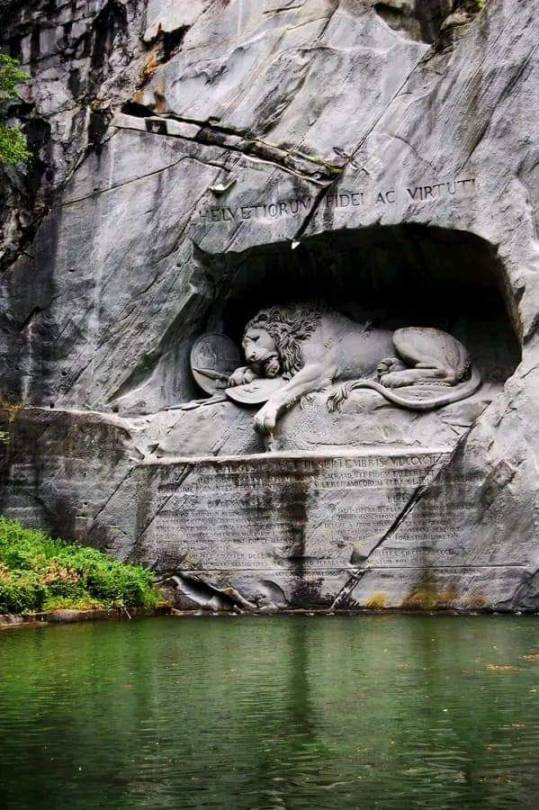
Lion of Lucerne is a memorial in Lucerne, Switzerland designed by Bertel Thorvaldsen and carved in 1820–21 by Lukas Ahorn.
The monument commemorates the Swiss Guards who lost their lives in 1792 during the French Revolution, when revolutionaries stormed the Tuileries Palace in Paris. The top inscription says Helvetiorum Fidei ac Virtuti which translates to "To the loyalty and bravery of the Swiss".
The monument depicts a dying lion impaled by a spear, covering a shield bearing the fleur-de-lis of the French monarchy. Next to him is another shield bearing the coat of arms of Switzerland. The inscription below show the names of the guards and provides the approximate numbers of soldiers who died (DCCLX = 760), and survived (CCCL = 350).
Mark Twain praised the sculpture of a mortally-wounded lion as "the most mournful and moving piece of stone in the world."
69 notes
·
View notes
Text

The Lion of Lucerne is a memorial in Lucerne, Switzerland designed by Bertel Thorvaldsen and carved in 1820-21 by Lukas Ahorn. The monument commemorates the 1792 massacre of Swiss guards during the French Revolution when they stormed the Tuileries Palace in Paris.
The top inscription says Helvetiorum Fidei ac Virtuti, which translates to "To the loyalty and bravery of the Swiss." The monument depicts a dying lion impaled by a spear, covering a shield bearing the fleur-de-lis of the French monarchy. Next to him is another shield bearing the coat of arms of Switzerland.
The inscription below shows the names of the guards and provides the approximate numbers of soldiers who died (DCCLX = 760) and survived (CCCL = 350). Mark Twain praised the sculpture of a mortally-wounded lion as "the most mournful and moving piece of stone in the world."
1 note
·
View note
Text
The Lion of Lucerne
The Lion of Lucerne, created in 1821 by the Danish sculptor Bertel Thorvaldsen, stands as a poignant and striking monument to commemorate the Swiss Guard soldiers who lost their lives during the tumultuous events of the French Revolution. This majestic sculpture is located in Lucerne, Switzerland, and has become an iconic symbol of bravery and sacrifice.
The monument itself is a masterful work of art, carved into a sandstone rock face. At the center of this somber tableau lies a colossal dying lion, its expression a mixture of pain, sorrow, and unwavering courage. The lion is depicted impaled by a spear, symbolizing the fallen Swiss Guards' tragic fate during the attack on the Tuileries Palace in Paris in 1792.
Thorvaldsen's attention to detail is evident in the intricate carving of the lion's mane, the textured rock surface, and the solemnity of the scene. Beneath the lion, an inscription in Latin pays tribute to the Guards' valor, translating to "To the loyalty and bravery of the Swiss." This inscription serves as a reminder of the selflessness and dedication displayed by these soldiers in their service to the French monarchy.
The story behind the Lion of Lucerne adds depth to its significance. The Swiss Guard was a mercenary force hired to protect the French monarchy, and on August 10, 1792, they found themselves defending the Tuileries Palace against a revolutionary mob. Despite being vastly outnumbered, many Swiss Guards fought to the death, steadfastly protecting their charges and their honor.
The Lion of Lucerne not only commemorates the heroism of the Swiss Guards but also serves as a symbol of the enduring Swiss commitment to neutrality and peace. It has become a destination for visitors from around the world, drawn not only by its artistic beauty but also by the compelling historical narrative it represents.

0 notes
Note
Pls share your thoughts about the gays in THAT scene… I would love to read them!
Ahh you are too kind, I am but a little swiss cheese brain but I'll try my best to sum up my thoughts, I have too many! I wanted a chance to grab some screenshots too! I'm going to put a read more because this is a long one buckle up lads.
So obviously the whole punishment for Hickey is designed to humiliate him (I would imagine this is one of the reasons his punishment isn't explained to him, because if Hickey truly was a naval petty officer he would know, and I think it's another way for Crozier to essentially say "I see you" and not in a good way). The fact we're not shown the other whippings shows the importance lies in the scene with Hickey.
I've seen a bit of discussion about his charge of "dirtiness", which isn't listed initially when we see him being questioned by the Captains, and whether or not it alludes to homosexuality but on a quick cursory search it does seem to have been used as a euphemism where an outright accusation of sodomy would mean a death sentence. The way Crozier throws it out there, no doubt to heap the humiliation onto Hickey and add crimes to the list to cover the fact he added lashes on to the punishment essentially for a bruised ego (but that's another matter), suggests a whole lot of venom to the accusation. Hickey's pointed look at Irving and Irving's quick shift of his gaze down suggests they both know exactly why Crozier has listed this among Hickey's list of crimes, and Hickey looks furious for it.
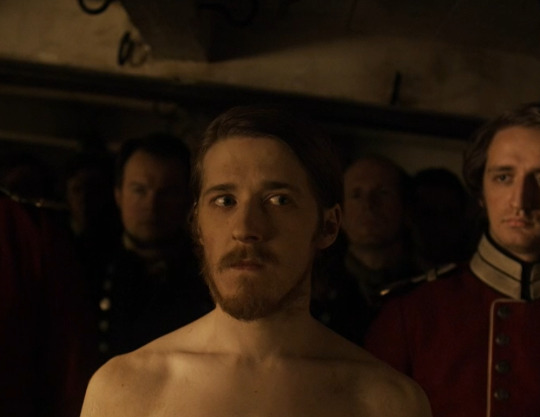
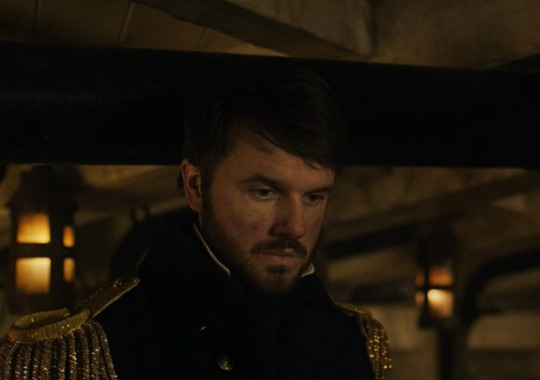
But I think this is also ultimately where the panic begins to set in. Again, there are far greater minds than me who have made excellent posts about queer coded characters in the terror, and I think it's no surprise that most of them are the faces that are focused on in this scence. It is clear long before this moment that Crozier's leadership is lacking, and people have already begun to voice concerns fairly loudly. Tozer for one is livid in the wake of Heather being injured, and the marines have clearly started distancing themselves from both the officers and the men. I feel like this scene, for a lot of characters is a point of major shift in either allegiences or character.
Tozer and the Captains are the first faces that are panned to in this scene and I think the expressions speak for themselves.
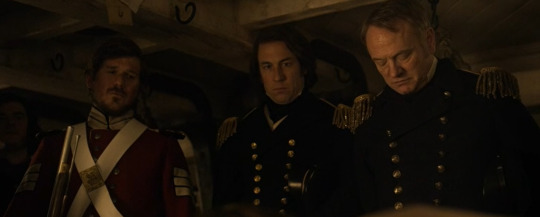
Tozer is visibly upset/concerned after the first lash. I do think guilt probably has a part to play, in that is was him whole told Hickey where Silna was, and presumably approved enough of the plan to not rat him out to anyone. Again, very probably part of Tozer's anger at Heather being injured due to what he sees is Crozier's poor management. Fitzjames is stoney faced, but is also the only one looking. As a man who many have noted pushes himself to pick emotional scabs, I think it would make sense for someone who is also notably queer coded and stuggles with trauma to make himself look directly at someone being whipped for a crime he himself might commit. Crozier isn't even looking, whether out of suddenly doubting his harshness or simply triggering something in his own memory it's not clear. I think the end of this shot also speaks for itself.

(Fig 1. Three Concerned (very likely not straight) men contemplate)
The lads at the back behind Mr. Johnson are all looking Directly At the whipping as it is taking place. Interestingly none of the men at the front near the table are looking. This is the stewards, officers, and marines. Whether out of respect or also Concern at their own skins (I think every one of these characters has been addressed as being queer coded at some point, minus the marines who are all, except Tozer, fairly nameless characters).
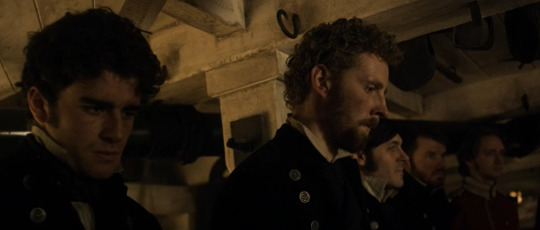
I'm not a gifmaker which is unfortunate for this section, though this is what is gifed in the beautiful gifset by sashneeka I reblogged (x). Tommy is also visibly upset, whether because he knows Tozer was involved in the plot to kidnap Silna and is concerned for him and any of the rest of the crew who had assisted in someway or voiced support. Billy interestingly does look briefly, and sets his jaw after in a way that suggests he's trying to fight the guilt of being the one to tell Irving about the whole affair with Hickey to paint himself in a better light. It could just as easily be Billy there on that table being lashed, but he somehow rationalises it in his head (probably because Hickey is a little bastard) that he was right in what he did. He does look down fairly guiltily after this, so maybe he hasn't quite settled on an opinion. Jopson also looks incredibly concerned/unsettled, and interestingly looks at Hickey right up until the whip hits where he flinches, and not for the only time in this scene. From what we know about Jopson's past, though not at this point, it may well be he is remembering similar punishment/mistreatment and like Fitzjames looks enough to pick the scab open and flinch from his own trauma.
The closeup of Hickey shows the full extent of his rage and humiliation building, and as I think Adam himself said, they whipped something out of Hickey that day and let him reach this potential that lay inside him (to become an even bigger bastard). He's fully severed all ties and feelings of loyalty after this and it becomes full on train to manipulation station from this point. I have a lot of Thoughts about Hickey also (which I am sure you are all aware of) but I think there was some semblance of Hickey attempting to start afresh on this journey, or at the very least keep his head down and go unnoticed. The trouble is, he notices Crozier as a flawed man, and one not from the upper classes like himself, and his ego can't help but think we're not so different, that could be me with the right connections. Well surprise lads, its murder time now and he's gonna make this old man pay for not recognising initiative but punishing it. I do wonder if Crozier wasn't booze sick and rattled from losing even more men under his command, would he not have come down so harshly for someone clearly defying the Articles to do what he thinks is right and save the men (a la Crozier and his fuck you I'm directly contradicting an order and leading this rescue party myself).
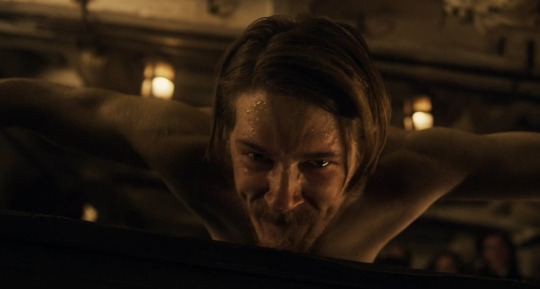
Tozer gets another wee closeup here and again looks like he has resolved something in his head too. Most likely that he thinks Crozier an unfit leader, and admiring Hickey for having the balls to do what he did (Hickey also never reveals anyone else who came with him, and when he talks about Hartnell and Mason's part in taking Silna it highlights their skill and bravery and (he thinks) commends them to the Captain. It's probably the only time we see him building up and applauding others). He looks dead ahead here and seems to have a very steely gaze, like yep fuck it looks like I'm going it alone now. It is interesting that Tozer goes from this to notably disliking Hickey (both at the start and when they are packing up - "you've just given me an excuse to give a big shove". This might be anger at Hickey having caused all the issues with Silna after the fact when Heather gets killed at Carnivale), but still follows him in the end. Hickey has the ability to kill, manipulate, steal, basically do whatever needed for their group to get ahead, which means Tozer can be part of the group and not have to dirty his own hands. I think Tozer probably has a complicated relationship with Hickey, but he does fall for the charm hook, line, and sinker, and the fact he seems concerned for him here suggests how easily he is sympathetic to those he sees as being wronged.
Gibby getting Hickey's blood on his hand (ayy) seems to visibly make him blanch, and I do find it interesting that the shot then pans to Tommy as though they are looking at each other when they are stood side by side. The similarities between them maybe? (I've seen and reblogged a lot of discourse about Tommy loving Tozer, maybe another nod to no one being so different to the man on the table?) Irving doesn't get much of a close up in the rest of this scene but bless him he looks equal parts terrified and guilty (another man who has been noted as having a list of many things to distract from the Gay Thoughts like why do you need to distract from Gay Thoughts Irving?). He also has the Far Off Look of trauma about him, probably because he too could just as easily be on that table.
I have many many thoughts about the way Hickey turns to look (and fucking smile???) at Crozier next, which is when Crozier is looking directly at him and Fitzjames looks at him. Like if I were Crozier I think my fucking blood would chill, look at this man. Being humiliated and lashed still hasn't broken him, if anything he has just become fully unhinged and looks at Crozier as though to say "did you really think this would work?". I would also say, this man has fairly quite for someone who is at this stage something like 22 lashes in? Like what the actual fuck Hickey?? I fully belive Hickey to be a psycopath, and most of what he does in the beginning of the series is an attempt to stay hidden until they get to Hawaii and he can ditch the crew, but I think it is fairly safe to say he isn't hiding it any more.
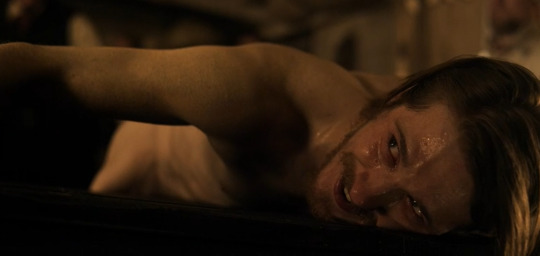
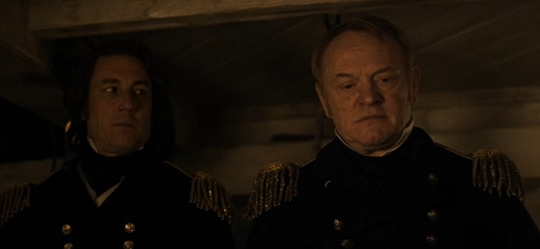
And he knows this is going to make the men doubt Crozier - I can't do a proper search because I am using my work laptop atm, but I seem to remember reading that a punishment greater than 12 lashes required a court martial (probably why Little steps in to say so when Crozier orders his punishment as well as them technically being lost at sea), which would be another strike against him as a Captain. Not only that, but Crozier does seem to grant him some mercy in letting him only be lashed I think 23 or so times? Probably because the tension is fucking palpable in this whole scene and Crozier can either choose to claw back some sense of control on the matter, or deal with the consequences of many people admiring Hickey for what he has done for the crew and start a mutiny. I think this is the first time Fitzjames sees the damage Crozier is doing to himself with his choices as Captain, and is probably just as concerned at the look Hickey is giving him. He knows this has unleashed something in this tiny rat bastard too, and that he will become the physical manifestation of Crozier's self-destructive tendancies. Crozier perpetually comes to everything just a fraction too late to change anything - he never saves any of the men, only comforts them as they die, and a lot of this has to do with his own ego and bad decision making, and I think this is the first example here of the fact his actions are having an effect on others to the point it will be his downfall.
Anyway, to round it off, I think this scene really epitomises the notion that Hickey is a mirror to the rest of the men, and they see their flaws in him. Those who have questioned Crozier's captaincy look concernced knowing they too could be being lashed. They too would have tried to get Silna to stop the Tuunbaq hunting them. Those who are queer or queer coded know they too could be being lashed for it. Crozier himself sees his unwillingness to follow the Articles in him, sees his own insubordination, and feels what Sir John meant when he said his position afforded him deference. Hickey may as well be a metaphor for all the men being lashed, theres not one among them who haven't voiced wanting to do what he has done. Let them without sin and all that. This is make or break for who holds loyalty to the Captain, and the turning point for who is going where. I think everyone except Jopson, Irving and Fitzjames ends up in the mutineers camp, and Irving ends up killed and mutilated by Hickey and Fitzjames is scavanged by them. Theres not one of them that isn't haunted by what happened in this scene, and Hickey would end up being the death of every single one of them. The only one who remains loyal after this is Jopson, who thinks his care and duty to the Captain can outweigh his other sins. Fitzjames and Crozier have a stronger relationship once he recovers from his withdrawal, yes, but Fitzjames also keeps him in check now (I'm thinking of Edward Little being threatened with flogging again because of course I am), and it is another step too late for Crozier's self-destruction. I've seen a Hickey/Fitzjames Christ analogy on here before too, so I hope you'll forgive me in comparing them, but Hickey in this scene really does get punished for everyone else's crimes in this scene, and becomes a sort of Christ-like figure, reborn as a complete version of the worst of himself from the pain of being lashed. They whipped something out of him!! Anyway, that about sums it up!
#long post#thank you for asking I could talk about the nuances of the terror for days#hickey thoughts
37 notes
·
View notes
Photo

The Meeting of Eastern and Western Lions 東西兩大獅的邂逅
#Lion of Lucerne Monument#by Bertel Thorvaldsen#To the loyalty and bravery of the Swiss#Lion of Yuantong Temple
0 notes
Text
Royal Headcanons
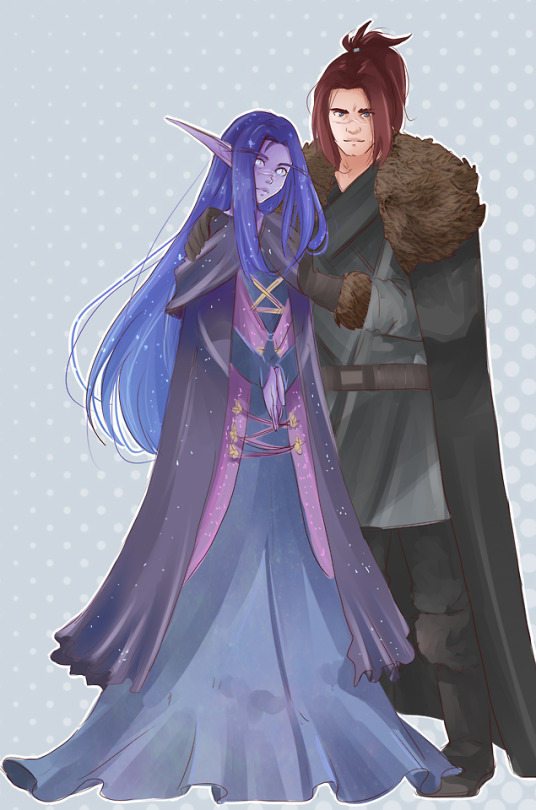
((This was inevitable to say the least. It begins with a few fics, then it goes to headcanons, and then I start investing a lot of my time essentially building the characters. Oh well! Shot out to @haleth who started this, and to @drew-winchester for drawing this piece. I wanna thank Haleth for essentially being the nicest Swiss I’ve had the pleasure to work with. I don’t claim to know the character’s myself, this is just what I thought might be how they met, fell in love, and various other things. I hope you enjoy!))
This would be the first time she and Varian officially met.
After the defeat of Saurfang’s son, Zireael would offer to help the orc with carrying his son to the ship. When asked by Varian why she would extend her kindness like that, she shrugs and says, “Because a father shouldn’t see the day he outlived his son.”
After the fight at the top of the Icecrown Citadel, she and her fellow adventurers were adorned with medals of bravery, honor, loyalty, and heroism.
(personal headcanon: BOTH faction heroes defeated the lich king at the same time. I mean, c’mon.)
She and her Alliance teammates were invited to a party in Stormwind Keep.
Not really finding comfort with wearing dresses, she showed up in her armor. Zireael was easily the most stand out woman there.
This caught the king’s attention though
(I mean, he’s used to nobles trying to sell themselves off to him in fancy dresses and pretty jewelry like everyday. So something completely different was very welcoming.)
Their friendship began with a debate on which is better: sword and shield or greatsword that turns into dual blades.
They didn’t immediately start dating, as Varian wanted to focus on being a good dad for his son. The night elf would respect his wishes, and even help the boy with swinging a sword.
The two sparring was Varian’s attempt at a date, as the poor man was not like his charismatic half at all.
The two eventually bonded over their shared enjoyment of a good fight, sometimes even getting a few cuts in!
One of their most intense fights ended with Varian disarming Ziri and pinning her to a wall. In a very strange mixture of hormones during the fight, the two would share their first kiss with each other.
It did not end with just a kiss~
The two spent more time around each other that wasn’t just fighting. The two would talk strategy, the best kind of parties, what noble to avoid, and how to best handle guards in the city.
Anduin is actually pretty supportive of his dad going out and seeing someone. Everyone needs to find someone.
The two had their cons as well, Ziri’s love for nature has caused Varian waking up to a garden in his room... multiple times.
During the Hour of Twilight raid, Zireael would be stopped by Varian. He proposes to her on the spot, saying “To give you a better reason to come back to me alive.”
She does make it back, and the two would hold each other in a loving embrace.
Anduin doesn’t see her as his mom, but definitely sees her as someone to respect. Especially since she makes his father incredibly happy.
The wedding would be planned, and originally was going to be at Darnassus until Pandaria was discovered.
The wedding was postponed until Anduin was found, since he’s lost a uncharted continent!
Ziri suggested she’d go, but was advised against by everyone. No one needed the soon to be wife of Varian to disappear too!
Luckily, Anduin was found, and the monstrous old god was defeated. Everything seemed well...
However, they got involved when Garrosh went bat sh*t insane and tried to kill everyone!
Ziri actually got to participate in this one, as she helped the heroes fight Corrupted Garrosh.
Before Garrosh’s trial, Zireael suggested the wedding be held in Pandaria. The continent had so much to deal with these past years(in game) that it only made sense that something positive could come to it.
The wedding went off without a cinch! Zireael Starsong became known as Zireael Wrynn.
Unfortunately honeymoon had to wait because of f*cking Garrosh was at it again!
Unfortunately again, Zireael had to keep out of this one again! The difference is less of the Queen of Stormwind in danger, and more of her being pregnant.
(Side note: I’m not familiar with royal succession thing, so to make it easier on myself: Zireael would be given the responsibilities of leading Stormwind in case of the king’s demise. Anduin is next in line, but if anything happened to him, Ziri’s baby would then inherit the throne.)
She’d be the quest giver instead of the adventurer this time. She did not care for it.
Draenor was finished, Azeroth was at peace, and Ziri could finally enjoy her time with her new family.
Until Legion happened. That is a story for another day...
#haleth#drew winchester#drew-winchester#zireael#zireael starsong#varian#varian wrynn#human#night elf#nelf#kaldorei#warrior#world of warcraft#wrath of the lich king#cataclysm#mists of pandaria#warlords of draenor#legion#not my art#not my oc#my writing#my otp#zakthefiend
51 notes
·
View notes
Photo
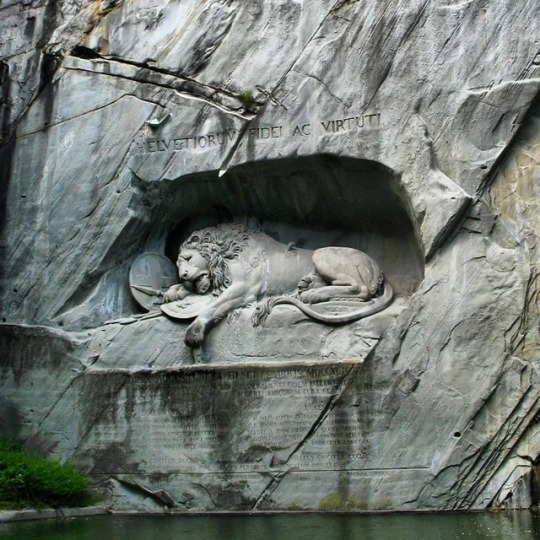
Lion of Lucerne is a memorial in Lucerne, Switzerland designed by Bertel Thorvaldsen and carved in 1820–21 by Lukas Ahorn. The monument commemorates the 1792 massacre of Swiss guards during the French Revolution when they stormed the Tuileries Palace in Paris. The top inscription says Helvetiorum Fidei ac Virtuti which translates to "To the loyalty and bravery of the Swiss". The monument depicts a dying lion impaled by a spear, covering a shield bearing the fleur-de-lis of the French monarchy. Next to him is another shield bearing the coat of arms of Switzerland. The inscription below show the names of the guards and provides the approximate numbers of soldiers who died (DCCLX = 760), and survived (CCCL = 350). Mark Twain praised the sculpture of a mortally-wounded lion as "the most mournful and moving piece of stone in the world." (at Luzern, Switzerland) https://www.instagram.com/p/Bz3rclSl9js/?igshid=wp5tyh6s5sbq
1 note
·
View note
Text
PSA about putting Tomione in real life Nazi settings
After I’ve gotten some more questions as to why I have issues with writing a Tomione with the holocaust as subject (see this post: http://nerysdax.tumblr.com/post/173906911067/lust ) when I normally am pretty much “write what you want and fuck the haters”, I was wondering why and how to properly word it. Yesterday night I couldn’t find the words. It hit too close to home. Here’s why.
When I was a young teenager, I became obsessed with WW2. I don’t remember exactly what started it, probably the combination of a book (about heroic people fighting the Germans and crossing the channel to flee to England) and the knowledge my still young grandparents went through that war. I was fascinated. Wanted to know everything. I badgered them. My grandfather had been in a German labor camp and my grandmother had done some minor resistance work by delivering fake identity documents. They as so many of their generation didn’t want to talk about it, but I learned snippets of their history. Now I know I was asking them to relive a horrible time, back then I was a curious youngster, who didn’t understand and I wanted to know and learn about this war. I wrote terrible Mary Sue stories about my shooting Hitler and saving the world, or about liberating camps, or shooting those horrible, horrible Germans and collaborators.
I wanted to know more, so I read every fictional book available. I knew this war. I felt it was inside of me, but fictional books didn’t quite cut it. I switched to history books. I watched movies. I learned about the hunt for Eichmann. I studied what Simon Wiesenthal was doing. I read everything about the holocaust. The horrors of the elimination of Jews, gay people, Romani, mentally disabled and anyone else out of the norm. I read about Mengele and his horrible experiments. I wanted to understand. The more I learned, the less I understood. This was a war I understood, this was a war I knew all about. It was black and white. Good and evil. How did people allow for this to happen when the fictional books I had read spoke of the bravery? I wrote a story about a young girl in a camp (based a lot on Anne Frank in hindsight) who survived (alas not based on Anne Frank) while her family perished. After all I knew this war. I knew this, too.
I became more critical about my own country, the Netherlands. We were the country the most Jews got transported from, the most who never came back, even if you adjust to percentages within the population, we still were in the dishonourable position of being the lead. I learned about the collaborators from their children. I learned about the silent majority to whom “Ik heb het niet geweten” (the dutch version of “Ich habe es nicht gewusst”) really didn’t fly. You had to have known. How could you not? How could you stay silent? How could you tell on your neighbours? How could you take their belongings? Why, why, why? To my teenage mind, it all seemed so clear. You had to make the right choice. Easy. So why wasn’t it that way? I began to write more critical fictional WW2 stories. Stories about collaborators, stories about someone not daring to speak up and looking the other way over and over and over again, until finally they were liberated and could pretend none of it was their fault. This was my war. I knew it.
I read about the Soviets fight, the questionable delay of the Allied Forces invasion over and over out of fear for Stalin. The immense cost of the Russian lives, because that second front stayed away. I still burn a candle on May 9th out of solidarity for the Russian lives lost, even though in the Netherlands we commemorate the dead on May 4th. I wrote a story about the siege on Leningrad. This was my war. The more I learned, the more I knew, the more I became fascinated.
I focused on the rise of Hitler. The economic cost of WW1 to Germany, the poverty, the promises he made, the unexplainable attraction he had on crowds, the choices of the German population and the responses at first abroad. The unemployment he combatted. I knew the war, I wanted to know the start. You don’t start with concentration camps, you start with little things. I wrote about the “Kristallnacht” and the slowly excluding of Jews in everyday life. I began to understand how Hitler could’ve risen to power. I knew this war. I wrote a story about a young German Wehrmacht soldier and his choices and dilemmas.
I learned about Italy, Mussolini. How a country seen as wrong still saved a lot of his Jewish population, while we (the good guys) had not. I looked at Denmark where the Royal Family didn’t flee and exerted influence to save people, while ours had not. I looked at Switzerland and the questionable decisions of their banks with regards to the Nazi gold (which was never theirs to begin with). I learned more and more and more of this war. This war was mine. I wrote stories about robbing a Swiss bank after the war. I wrote a story where our royal family had stayed and its possible impact, including the questionable loyalties and position of then Prins Bernhard.
This was a war I knew. This was MY war. This was a war I began to understand.
Then I went to Auschwitz.
The immensity of it hit me like a ton of bricks. I felt it so profoundly that day. I still can’t think of that monument without crying.
And I realised something important.
I knew nothing.
This was not my war.
These weren’t my stories to tell.
These words belonged to other people.
“So we may never forget”. Yes, we need to remember. Yes, we need to retell the stories of those who were there, of those people it impacted on, of those who survived and those who did not. The real stories.
I often see people say when they write fiction about WW2, “We need to tell these stories so it never happens again.”
And I say, how arrogant. How arrogant of you to think that your fiction will do what the true stories of survivors did not. How arrogant to think you can appropriate something so horrific and do it better than those who lived it. How arrogant was I.
It happened and is happening again. We were there in Srebrenica; we stood by and watched. We were there in Rwanda, we stood by another genocide and did nothing. We are there in Myanmar, we make some fleeting comment about how bad it is what they’re doing to the Rohingyas and move on with our lives. We are there with North Korea; we don’t even comment about those concentration camps, because they only concern their own population after all. Those rockets that might hit ocean are a bigger deal to us. The internet, and before that, television means we are always there and we always do nothing.
We need to remember, we need to tell the true stories. Not for our amusement. Not for our entertainment. Not for our desire for angst. Not for a cheap thrill. But so that maybe someday, we will finally open our eyes and truly see. So that maybe someday, we will finally say, “stop, no further!” So that maybe someday, we will finally learn from history. So that maybe someday, when a person like Hitler tries to take control, we will say, “not on our watch.”
45 notes
·
View notes
Photo

People that have married in to the Royal Families since 1800 Spam
Netherlands
Prince Bernhard of Lippe-Biesterfeld
Prince Bernard was a German-born prince who was the consort of Queen Juliana of the Netherlands; they were the parents of four children, including the former Queen of the Netherlands, Princess Beatrix.
He belonged to the princely House of Lippe and was a nephew of the Principality of Lippe's last sovereign Leopold IV.
From birth he held the title Count of Biesterfeld; his uncle raised him to princely rank with the style of Serene Highness in 1916.
He studied law and worked as an executive secretary at the Paris office of IG Farben.
In 1937 he married Princess Juliana of the Netherlands, after meeting the year before at the Olympics, and was immediately given the title Prince of the Netherlands with the style of Royal Highness. Upon his wife's accession to the throne he became the Prince Consort of the Netherlands in 1948.
Although his private life was rather controversial, he was still generally regarded as a charming and popular figure by the majority of the Dutch for his performance as a combat pilot and his activities as a liaison officer and personal aide to the Queen during World War II and for his work during post-war reconstruction.
During World War II he was part of the London-based Allied war planning councils and saw active service as a Wing Commander (RAF) flying both fighter and bomber planes into combat. He was a Dutch General and Supreme Commander of the Dutch Armed forces, involved in negotiating the terms of surrender of the German Army in the Netherlands.
For proven bravery, leadership and loyalty during his wartime efforts he was appointed a Commander of the Military William Order, the Netherlands' oldest and highest honour.
After the War he was also made Honorary Air Marshal of the RAF by Queen Elizabeth II. In 1969,
Bernhard was awarded the Grand Cross (Special Class) of the Order of Merit of the Federal Republic of Germany.
Bernhard helped found the World Wildlife Fund (later renamed World Wide Fund for Nature), becoming its first President in 1961, and in 1970 establishing the WWF's financial endowment "The 1001: A Nature Trust".
In 1954, he was a co-founder of the international Bilderberg Group, which has met annually since then to discuss corporate globalization and other issues concerning Europe and North America.
He was forced to step down from both groups after being involved in the Lockheed Bribery Scandal.
Scandal rocked the Royal Family in 1976 when it was revealed that Prince Bernhard had accepted a US$1.1 million bribe from U.S. aircraft manufacturer Lockheed Corporation to influence the Dutch Government's purchase of fighter aircraft. At the time he had served on more than 300 corporate boards and committees worldwide and had been praised in the Netherlands for his efforts to promote the economic well-being of the country. Prime Minister of the Netherlands Joop den Uyl ordered an inquiry into the Lockheed affair, while Prince Bernhard refused to answer reporters' questions, stating: "I am above such things".
The Dutch and international press headlined the stories for months, providing records of Prince Bernhard's Reiter SS membership and details of his numerous extramarital affairs, including the purchase of a luxurious Paris apartment for his mistress Hélène Grinda, with whom he had an illegitimate daughter, Alexia. (Bernhard also had a second illegitimate daughter, Alicia, in the US.)
On 26 August 1976, a toned-down, but nonetheless devastating, report on Prince Bernhard's activities was released to a shocked Dutch public. The Prince's own letter of 1974, to Lockheed Corporation, demanding "commissions" be paid to him on Dutch Government aircraft purchases was very damaging evidence of improper conduct by the Inspector-General of the Dutch Armed Forces.
Criminal charges were not pressed by the Government out of respect for Queen Juliana, whose later abdication was tacitly understood to be directly related to her husband's conduct.
Prince Bernhard resigned as Inspector-General of the Dutch Armed Forces. This meant that he was no longer officially allowed to wear a uniform in public, but it did not stop him from attending the 1979 funeral of Lord Mountbatten in London in full military dress.
Prime Minister Joop den Uyl made a statement in Parliament and told the delegates that the Prince would also resign from his various high-profile positions in businesses, charities, and other institutions. The Dutch States-General voted against criminal prosecution. Prince Bernhard turned over the Presidency of the international World Wildlife Fund to Prince Philip, Duke of Edinburgh.
In 1988, Prince Bernhard and Princess Juliana sold two paintings from their personal collection to raise money for the World Wildlife Fund. The paintings sold for GBP700,000, which was deposited in a Swiss WWF bank account. In 1989, however, Charles de Haes, Director-General of the WWF, transferred GBP500,000 back to Bernhard, for what De Haes called a private project.
In 1991, newspapers reported what this private project was: Prince Bernhard had hired KAS International, owned by Special Air Service founder Sir David Stirling, to use mercenaries – mostly British – to fight poachers in nature reserves. The paramilitary group infiltrated organisations profiting from illegal trade in ivory in order to arrest them.
This Project Lock seemed to have backfired enormously, however. Bernhard's private army had not only infiltrated in the illegal trade, they were also participating in it. To make things worse, Irish reporter Kevin Dowling discovered that the South African Army was also involved in the trade, hinting at connections between the Bernhard's troops and the WWF and the struggle for maintaining Apartheid. Moreover, he claimed members of the South African-run counterinsurgency unit Koevoet (Afrikaans and Dutch for "crowbar") had been trained under Project Lock.
In 1995, Nelson Mandela called upon the Kumleben Commission to investigate, among other things, the role of the WWF in apartheid-South Africa. In the report that followed, it was suggested that mercenaries from Project Lock had planned assassinations of ANC members and that mercenaries had been running training camps in the wildlife reserves, training fighters from the anti-communist groups UNITA and Renamo. Although Prince Bernhard was never accused of any crime in this context, the Project Lock scandal dealt another damaging blow to the Prince's reputation.
Prince Bernhard died of cancer at the age of 93 at University Medical Center Utrecht in Utrecht on 1 December 2004
21 notes
·
View notes
Photo

Day 34: Lion Monument in Luzern (Helvetiorum Fidei ac Virtuti = To the loyalty and bravery of the Swiss) 760 were massacred!
48 notes
·
View notes
Video
youtube

10th of August, 1792: The French King orders the Swiss to lay down their arms
On the 10th of August, 1792, abused by false promises and contradictory news, Louis XVI King of France decided to abandon the Tuileries Palace to place himself under the "protection" of the National Assembly.
Escorted by a Swiss soldiers company commanded by the Captain d’Erlach and flanked by fifty grenadiers of the Filles Saint-Thomas (a National Guard battalion), the King and his family surrendered to the National Assembly.
For endless hours the King’s escort, and then the soldiers assigned to the Tuileries protection, will endure the raging attacks of a crowd hungry for revenge.
In the confusion of these dark hours, a message from the King to the Swiss to retire to their barracks would be misinterpreted by an emissary.
It will lead the Swiss soldiers to leap to the rescue of the King, who was detained in the National Assembly.
After having suffered heavy casualties, they managed to meet the King – to whom they all had sworn on their honor to protect with loyalty, only to found out he has been deprived of all his powers.
Believing he would still be able to save them, the King ordered that the Swiss soldiers surrendered their arms to the National Guard.
In doing so, he signed the death sentence of his faithful Swiss.
His order of the 10th of August, 1792 is still preserved in the Museum of the Carnavalet. Here it is:
The King orders the Swiss to lay down their arms at once, and to withdraw to their barracks.
On roughly 950 Swiss officers, non-commissioned officers and soldiers in office, 850 were slaughtered between the 10th of August and the 3rd of September, 1792.
This unbelievable sacrifice is the consequence of both orders from a weak and undecided sovereign and a mob (manipulated by the Jacobins and and various revolutionary clubs) savagery, combined with the enduring discipline of the Swiss regiments in foreign service.
The news of this bloodbath echoed in Switzerland, where the strongest indignation was felt.
The Tuileries slaughter and the account of the atrocities committed against the Swiss soldiers marked the end of the good relations between the French Kingdom and the Diet, which had prevailed since 1453, the date of the first alliance between French and Swiss.
10th of August, 2017: the EU orders the Swiss to lay down their arms.…
225 years separate these two summons, but with always the same will behind these words: disarm!
In 2017, edicts come no more from a King of divine right but from a self-proclaimed European Commission - with as much democratic legitimacy.
Today, the power-hungry EC strikes equaly the Poles (reluctant to change their laws), freedom and security-loving Czechs, or Hungarians simply refusing contingents of illegal migrants.
225 years later… it’s always the same story: the Swiss must surrender!
To these words, the quote of Sergeant Blaser from Solothurn is echoing:
We are Swiss and the Swiss surrender their weapons only with their life!
Savièse, August the 10, 2017, Robin Udry General Secretary of proTELL
On August 7, 1817, the Federal Diet ordered the distribution of a commemorative medal to the 345 survivors of the French Guard Regiment of France.
In 1818, Karl Pfyffer von Altishofen, a Swiss Guards Regiment officer on leave at the time of the Tuileries slaughter, organized a fund-raising campaign for the creation of a monument in honor of his missing comrades.
Between 1820 and 1821, the famous Lion of Lucerne is carved out of an old quarry, reminding the virtues of the Swiss soldiers at service of France. The engraved motto is: Helvetiorum Fidei ac Virtuti (To the loyalty and bravery of the Swiss).
This monument is one of the most visited in Switzerland with more than 1.4 million visitors a year.
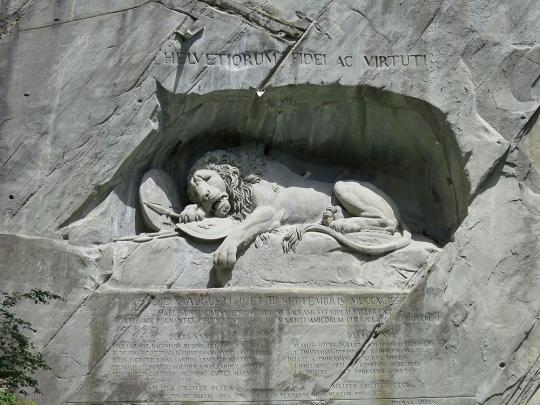
You too can help the fight for Switzerland independence and freedom by supporting Protell : https://protell.ch/
Please like that video and subscribe to Protell Youtube channel in order to make our message heard loud and clear.

We need all the signal boost available - the battle for our rights is only beginning.

120 notes
·
View notes
Photo

The Dying Lion of Lucerne is one of the most beautiful, moving monuments we’ve seen 🦁 Carved into the cliff face of a former sandstone quarry, it commemorates the Swiss Guards who lost their lives during the French Revolution 🙏 The inscription above reads, “To the loyalty and bravery of the Swiss.” • • • • #switzerland #switzerland🇨🇭 #centraleurope #lucerne #dyinglion #swissguard #monument #beautifulsculpture #evergibwanders #wandersineurope #visitswitzerland #instaswitzerland #loveswitzerland #igersswitzerland #ig_switzerland #igswitzerland #visitlucerne #lovelucerne #wanderlust #passionpassport #tlpicks #openmyworld #lovetotravel #worldtravelbook #besteuropephotos #topeuropephoto #storybehindsquares #aplacetoremember #europethroughthebackdoor (at Luzern, Switzerland) https://www.instagram.com/p/BmvXo7Fh618/?utm_source=ig_tumblr_share&igshid=1bzsm5ac6e16q
#switzerland#switzerland🇨🇭#centraleurope#lucerne#dyinglion#swissguard#monument#beautifulsculpture#evergibwanders#wandersineurope#visitswitzerland#instaswitzerland#loveswitzerland#igersswitzerland#ig_switzerland#igswitzerland#visitlucerne#lovelucerne#wanderlust#passionpassport#tlpicks#openmyworld#lovetotravel#worldtravelbook#besteuropephotos#topeuropephoto#storybehindsquares#aplacetoremember#europethroughthebackdoor
0 notes
Text
UNRAVEL THE WONDERS OF EUROPE

Traverse across Europe and discover the diverse offerings encompassing the continent.
With a whole continent named after a figure in Greek mythology, Europe has stood as a prime example of man’s greatest potential and achievements. The continent is also renowned for its vital contributions to art, cuisine, and architecture, which have influenced both the civilizations of old and the new. Its turbulent past fills the pages of most history textbooks today, but more importantly, the rise and fall of empires have played a crucial role in shaping not only the future of Europe but that of the world’s as well. Besides playing a significant role in world history, the natural and man-made wonders of modern Europe has inspired millions around the globe to seek out and form their own perceptions of this great continent.
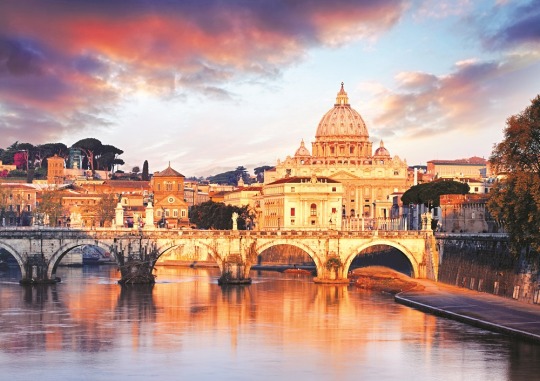
Italy, Rome
Famed for its Mediterranean coastline and its turquoise waters, Italy is a country renowned for its food and Renaissance masterpieces. It’s capital, Rome is famous for being the home to the Vatican - the seat of the Roman Catholic Church and the Pope. Despite being one of the world’s smallest state, the Vatican City remains as one of the most visited sites in the world. The city-state even has its own railway station, flag, and anthem. If that’s not impressive, it also has its own post office (and stamps). So the next time you visit the Vatican, be sure to send someone back home a postcard. The Vatican is also known for the distinguished St. Peter’s Basilica -one of the largest churches in the world. It boasts intricate works of art and an opulent interior behind its grandiose facade. When in Rome...visit the Colosseum. Commissioned around 70 A.D., the site once hosted sporting events, celebrations, wild animal fights, and more famously, gladiatorial combats. Seating up to 80,000 people, it’s the largest of its kind ever built. Although the massive stone amphitheater has fallen into disarray and left to the elements, it still remains a popular destination to this day.

While here, consider making a quick stop at the Trevi Fountain. As the largest Baroque fountain in the city, it is also the most photogenic in the world. Dating back to ancient Roman times, the fountain was built at the end point of the aqueduct, at the junction of three roads. The fountain’s name is derived from these three roads or streets - tre vie or Three Street Fountain.

Italy, Venice
Long and exquisite gondolas float leisurely along the myriad of canals that snake through the timeless city of Venice. Instead of cars or roads, narrow canals act as connecting pathways and small boats/water buses are utilised as a means of transport. Opulently fashioned buildings and historic monuments seem to rise from the depths of Venice, charming travellers from all over with its unique layout. Also known as Piazza San Marco, the St. Mark’s Square is noted for housing most of Venice’s rich history and architectural wonders. Since most of the city’s sights are concentrated here, it has become a major tourist attraction. Established in the ninth century, it is the largest square in the city and hence is known as a piazza - while the other city squares in Venice are referred to as “campi”. Besides being home to popular attractions such as the St. Mark’s Basilica, Doge’s Palace, and many others. Piazza San Marco is also a place where the most important government buildings and other facilities play a crucial role in the city’s activities are situated. Doge’s Palace represents Gothic architecture at its finest while serving as a distinguished landmark in Venice. Steeped in history, the Doge’s Palace has served many purposes in the past, from being the seat of the Venetian government to being the residence of the Doge (chief magistrate of Venice or Genoa). Today, it is a museum and exhibits paintings that were exclusively created to embellish the Doge’s Palace. The main entrance of the palace, the Porta della Carta, links the Doge’s Palace and St. Mark’s Basilica. Filled with intricate ornamental carvings, the figures above the entrance- Doge Francesco Foscari kneeling before the Lion of St. Mark - symbolises the power of the state. Another notable feature of the Doge’s Palace is the Scala dei Giganti - Staircase of the Giants - which leads up to the State Apartments on the upper floor - it is flanked on either side by two large statues of Mars and Neptune.
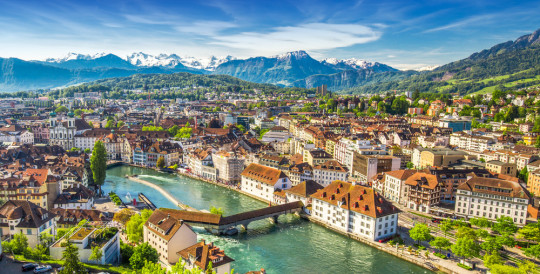
Switzerland, Lucerne
Nestled amid snow-capped mountains and lush greenery that stretches as far as the eye can see, Lucerne captures the image of a fairy tale Swiss town. As an ideal starting point for many travellers - the gateway to central Switzerland - the city has attractions that captivate visitors with its modest yet rich offerings of age-old monuments and structures steeped in history.

The Lion Monument is one of the most popular attractions in Lucerne. It was erected in the 1880s to honour the valour of mercenary soldiers from Central Switzerland. The monument - of a giant dying lion - commemorates Swiss soldiers who sacrificed their lives while serving the French king Louis XVI during the French Revolution. A Latin inscription is also carved into the sandstone wall, like an incantation, it reads HELVETIORUM FIDEI AC VIRTUTI, which means “To the loyalty and bravery of the Swiss”. Records of the dead, such as their names and death toll, can be found on the memorial. The Old Chapel Bridge plays a crucial role in the city of Lucerne. Connecting the Old Town and a New Town, this structure has been serving its purpose since 1332 - although it was rebuilt after being damaged by a fire. Unlike other bridges, the Old Chapel Bridge exhibits old paintings under its roofs. Interestingly enough, a few burnt panels are still displayed to serve as a reminder of the tragic fire that took place in 1993. During the carnival season, the original pictures will be replaced with the modern ones to reflect the carnival atmosphere.
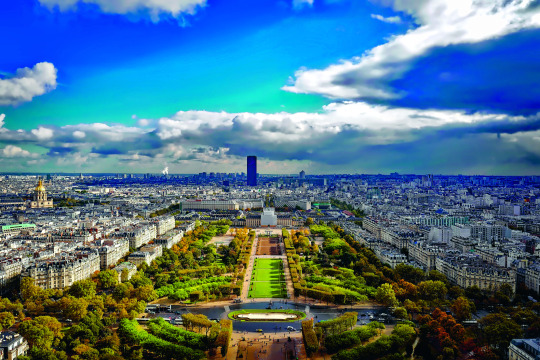
France, Paris
Paris is a timeless city that conjures up images of charming street side cafes, iconic structures, and world-renowned branded stores. For years, the capital of France has enchanted visitors with its romantic ambience, and architectural wonders. This cosmopolitan city attracts numerous travellers from all over the world to embrace its rich culture, fine cuisine, and influential art pieces. Noted for being the world’s most beautiful avenue, the Avenue des Champs-Elysees is an attraction as great as the iconic Eiffel Tower itself. Both Parisians and tourists stroll along these picturesque streets and take in the sights and sounds of the city. This two-kilometre stretch is situated between the Place de la Concorde and the Arc de Triomphe. Famous restaurants, luxury boutiques, and flagship stores are widely known by many are lined along this street; some of the biggest names include, Hard Rock Café, Louis Vuitton, Sephora, etc. The Avenue des Champs-Elysees has also been the setting for major events such as the Bastille Day military parade, the arrival of the Tour de France and the Christmas lights. Conclude your visit to the Avenue des Champs-Elysees by climbing to the Arc de Triomphe - a triumphal arch that stands imposingly to commemorate the soldiers and generals who lost their lives fighting for France during the Napoleonic Wars.
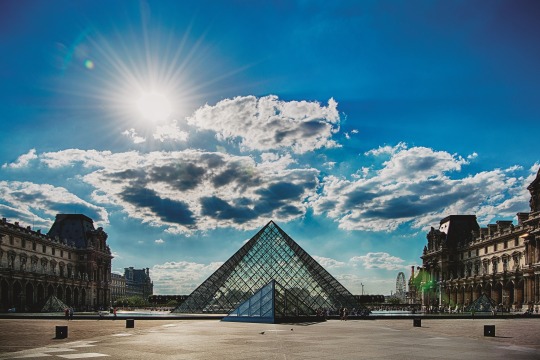
The Louvre Museum is an ideal place for any art enthusiast to satisfy their thirst for masterpieces and impressive art collections. The historic monument is a central landmark of the city, and attracts art enthusiasts from all over the world. As the world’s largest museum, the art gallery holds Egyptian antiquities, notable paintings, Renaissance and Medieval artwork; and a collection of ancient sculptures ranging from the Medieval and Romanesque era. Visitors flock to the museum every day to look at the Louvre’s most famous work, Leonardo da Vinci’s “Mona Lisa”. The museum was originally built as a fortress in 1190, but was reconstructed in the 16th century to serve as a royal palace. Visitors can also see the Louvre pyramid when they take the main entrance to the Louvre Museum. The glass pyramid structure was installed in 1988 to provide light into the underground lobby of the museum.
Photo credit: © 123RF
http://www.euholidays.com.sg/
0 notes
Photo

People that have married in to the Royal Families since 1800 Spam
Netherlands
Prince Bernhard of Lippe-Biesterfeld
Prince Bernard was a German-born prince who was the consort of Queen Juliana of the Netherlands; they were the parents of four children, including the former Queen of the Netherlands, Princess Beatrix.
He belonged to the princely House of Lippe and was a nephew of the Principality of Lippe's last sovereign Leopold IV.
From birth he held the title Count of Biesterfeld; his uncle raised him to princely rank with the style of Serene Highness in 1916.
He studied law and worked as an executive secretary at the Paris office of IG Farben.
In 1937 he married Princess Juliana of the Netherlands, after meeting the year before at the Olympics, and was immediately given the title Prince of the Netherlands with the style of Royal Highness. Upon his wife's accession to the throne he became the Prince Consort of the Netherlands in 1948.
Although his private life was rather controversial, he was still generally regarded as a charming and popular figure by the majority of the Dutch for his performance as a combat pilot and his activities as a liaison officer and personal aide to the Queen during World War II and for his work during post-war reconstruction.
During World War II he was part of the London-based Allied war planning councils and saw active service as a Wing Commander (RAF) flying both fighter and bomber planes into combat. He was a Dutch General and Supreme Commander of the Dutch Armed forces, involved in negotiating the terms of surrender of the German Army in the Netherlands.
For proven bravery, leadership and loyalty during his wartime efforts he was appointed a Commander of the Military William Order, the Netherlands' oldest and highest honour.
After the War he was also made Honorary Air Marshal of the RAF by Queen Elizabeth II. In 1969,
Bernhard was awarded the Grand Cross (Special Class) of the Order of Merit of the Federal Republic of Germany.
Bernhard helped found the World Wildlife Fund (later renamed World Wide Fund for Nature), becoming its first President in 1961, and in 1970 establishing the WWF's financial endowment "The 1001: A Nature Trust".
In 1954, he was a co-founder of the international Bilderberg Group, which has met annually since then to discuss corporate globalization and other issues concerning Europe and North America.
He was forced to step down from both groups after being involved in the Lockheed Bribery Scandal.
Scandal rocked the Royal Family in 1976 when it was revealed that Prince Bernhard had accepted a US$1.1 million bribe from U.S. aircraft manufacturer Lockheed Corporation to influence the Dutch Government's purchase of fighter aircraft. At the time he had served on more than 300 corporate boards and committees worldwide and had been praised in the Netherlands for his efforts to promote the economic well-being of the country. Prime Minister of the Netherlands Joop den Uyl ordered an inquiry into the Lockheed affair, while Prince Bernhard refused to answer reporters' questions, stating: "I am above such things".
The Dutch and international press headlined the stories for months, providing records of Prince Bernhard's Reiter SS membership and details of his numerous extramarital affairs, including the purchase of a luxurious Paris apartment for his mistress Hélène Grinda, with whom he had an illegitimate daughter, Alexia. (Bernhard also had a second illegitimate daughter, Alicia, in the US.)
On 26 August 1976, a toned-down, but nonetheless devastating, report on Prince Bernhard's activities was released to a shocked Dutch public. The Prince's own letter of 1974, to Lockheed Corporation, demanding "commissions" be paid to him on Dutch Government aircraft purchases was very damaging evidence of improper conduct by the Inspector-General of the Dutch Armed Forces.
Criminal charges were not pressed by the Government out of respect for Queen Juliana, whose later abdication was tacitly understood to be directly related to her husband's conduct.
Prince Bernhard resigned as Inspector-General of the Dutch Armed Forces. This meant that he was no longer officially allowed to wear a uniform in public, but it did not stop him from attending the 1979 funeral of Lord Mountbatten in London in full military dress.
Prime Minister Joop den Uyl made a statement in Parliament and told the delegates that the Prince would also resign from his various high-profile positions in businesses, charities, and other institutions. The Dutch States-General voted against criminal prosecution. Prince Bernhard turned over the Presidency of the international World Wildlife Fund to Prince Philip, Duke of Edinburgh.
In 1988, Prince Bernhard and Princess Juliana sold two paintings from their personal collection to raise money for the World Wildlife Fund. The paintings sold for GBP700,000, which was deposited in a Swiss WWF bank account. In 1989, however, Charles de Haes, Director-General of the WWF, transferred GBP500,000 back to Bernhard, for what De Haes called a private project.
In 1991, newspapers reported what this private project was: Prince Bernhard had hired KAS International, owned by Special Air Service founder Sir David Stirling, to use mercenaries – mostly British – to fight poachers in nature reserves. The paramilitary group infiltrated organisations profiting from illegal trade in ivory in order to arrest them.
This Project Lock seemed to have backfired enormously, however. Bernhard's private army had not only infiltrated in the illegal trade, they were also participating in it. To make things worse, Irish reporter Kevin Dowling discovered that the South African Army was also involved in the trade, hinting at connections between the Bernhard's troops and the WWF and the struggle for maintaining Apartheid. Moreover, he claimed members of the South African-run counterinsurgency unit Koevoet (Afrikaans and Dutch for "crowbar") had been trained under Project Lock.
In 1995, Nelson Mandela called upon the Kumleben Commission to investigate, among other things, the role of the WWF in apartheid-South Africa. In the report that followed, it was suggested that mercenaries from Project Lock had planned assassinations of ANC members and that mercenaries had been running training camps in the wildlife reserves, training fighters from the anti-communist groups UNITA and Renamo. Although Prince Bernhard was never accused of any crime in this context, the Project Lock scandal dealt another damaging blow to the Prince's reputation.
Prince Bernhard died of cancer at the age of 93 at University Medical Center Utrecht in Utrecht on 1 December 2004
5 notes
·
View notes
Photo
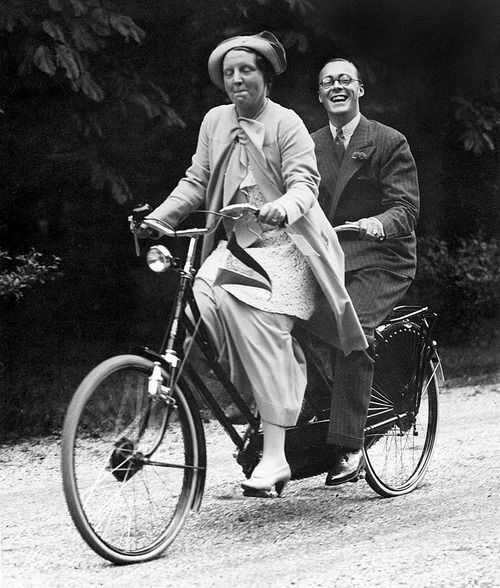
People that have married in to the Royal Families since 1800 Spam
Netherlands
Prince Bernhard of Lippe-Biesterfeld
Prince Bernard was a German-born prince who was the consort of Queen Juliana of the Netherlands; they were the parents of four children, including the former Queen of the Netherlands, Princess Beatrix.
He belonged to the princely House of Lippe and was a nephew of the Principality of Lippe's last sovereign Leopold IV.
From birth he held the title Count of Biesterfeld; his uncle raised him to princely rank with the style of Serene Highness in 1916.
He studied law and worked as an executive secretary at the Paris office of IG Farben.
In 1937 he married Princess Juliana of the Netherlands, after meeting the year before at the Olympics, and was immediately given the title Prince of the Netherlands with the style of Royal Highness. Upon his wife's accession to the throne he became the Prince Consort of the Netherlands in 1948.
Although his private life was rather controversial, he was still generally regarded as a charming and popular figure by the majority of the Dutch for his performance as a combat pilot and his activities as a liaison officer and personal aide to the Queen during World War II and for his work during post-war reconstruction.
During World War II he was part of the London-based Allied war planning councils and saw active service as a Wing Commander (RAF) flying both fighter and bomber planes into combat. He was a Dutch General and Supreme Commander of the Dutch Armed forces, involved in negotiating the terms of surrender of the German Army in the Netherlands.
For proven bravery, leadership and loyalty during his wartime efforts he was appointed a Commander of the Military William Order, the Netherlands' oldest and highest honour.
After the War he was also made Honorary Air Marshal of the RAF by Queen Elizabeth II. In 1969,
Bernhard was awarded the Grand Cross (Special Class) of the Order of Merit of the Federal Republic of Germany.
Bernhard helped found the World Wildlife Fund (later renamed World Wide Fund for Nature), becoming its first President in 1961, and in 1970 establishing the WWF's financial endowment "The 1001: A Nature Trust".
In 1954, he was a co-founder of the international Bilderberg Group, which has met annually since then to discuss corporate globalization and other issues concerning Europe and North America.
He was forced to step down from both groups after being involved in the Lockheed Bribery Scandal.
Scandal rocked the Royal Family in 1976 when it was revealed that Prince Bernhard had accepted a US$1.1 million bribe from U.S. aircraft manufacturer Lockheed Corporation to influence the Dutch Government's purchase of fighter aircraft. At the time he had served on more than 300 corporate boards and committees worldwide and had been praised in the Netherlands for his efforts to promote the economic well-being of the country. Prime Minister of the Netherlands Joop den Uyl ordered an inquiry into the Lockheed affair, while Prince Bernhard refused to answer reporters' questions, stating: "I am above such things".
The Dutch and international press headlined the stories for months, providing records of Prince Bernhard's Reiter SS membership and details of his numerous extramarital affairs, including the purchase of a luxurious Paris apartment for his mistress Hélène Grinda, with whom he had an illegitimate daughter, Alexia. (Bernhard also had a second illegitimate daughter, Alicia, in the US.)
On 26 August 1976, a toned-down, but nonetheless devastating, report on Prince Bernhard's activities was released to a shocked Dutch public. The Prince's own letter of 1974, to Lockheed Corporation, demanding "commissions" be paid to him on Dutch Government aircraft purchases was very damaging evidence of improper conduct by the Inspector-General of the Dutch Armed Forces.
Criminal charges were not pressed by the Government out of respect for Queen Juliana, whose later abdication was tacitly understood to be directly related to her husband's conduct.
Prince Bernhard resigned as Inspector-General of the Dutch Armed Forces. This meant that he was no longer officially allowed to wear a uniform in public, but it did not stop him from attending the 1979 funeral of Lord Mountbatten in London in full military dress.
Prime Minister Joop den Uyl made a statement in Parliament and told the delegates that the Prince would also resign from his various high-profile positions in businesses, charities, and other institutions. The Dutch States-General voted against criminal prosecution. Prince Bernhard turned over the Presidency of the international World Wildlife Fund to Prince Philip, Duke of Edinburgh.
In 1988, Prince Bernhard and Princess Juliana sold two paintings from their personal collection to raise money for the World Wildlife Fund. The paintings sold for GBP700,000, which was deposited in a Swiss WWF bank account. In 1989, however, Charles de Haes, Director-General of the WWF, transferred GBP500,000 back to Bernhard, for what De Haes called a private project.
In 1991, newspapers reported what this private project was: Prince Bernhard had hired KAS International, owned by Special Air Service founder Sir David Stirling, to use mercenaries – mostly British – to fight poachers in nature reserves. The paramilitary group infiltrated organisations profiting from illegal trade in ivory in order to arrest them.
This Project Lock seemed to have backfired enormously, however. Bernhard's private army had not only infiltrated in the illegal trade, they were also participating in it. To make things worse, Irish reporter Kevin Dowling discovered that the South African Army was also involved in the trade, hinting at connections between the Bernhard's troops and the WWF and the struggle for maintaining Apartheid. Moreover, he claimed members of the South African-run counterinsurgency unit Koevoet (Afrikaans and Dutch for "crowbar") had been trained under Project Lock.
In 1995, Nelson Mandela called upon the Kumleben Commission to investigate, among other things, the role of the WWF in apartheid-South Africa. In the report that followed, it was suggested that mercenaries from Project Lock had planned assassinations of ANC members and that mercenaries had been running training camps in the wildlife reserves, training fighters from the anti-communist groups UNITA and Renamo. Although Prince Bernhard was never accused of any crime in this context, the Project Lock scandal dealt another damaging blow to the Prince's reputation.
Prince Bernhard died of cancer at the age of 93 at University Medical Center Utrecht in Utrecht on 1 December 2004
2 notes
·
View notes
Photo

People that have married in to the Royal Families since 1800 Spam
Netherlands
Prince Bernhard of Lippe-Biesterfeld
Prince Bernard was a German-born prince who was the consort of Queen Juliana of the Netherlands; they were the parents of four children, including the former Queen of the Netherlands, Princess Beatrix.
He belonged to the princely House of Lippe and was a nephew of the Principality of Lippe's last sovereign Leopold IV.
From birth he held the title Count of Biesterfeld; his uncle raised him to princely rank with the style of Serene Highness in 1916.
He studied law and worked as an executive secretary at the Paris office of IG Farben.
In 1937 he married Princess Juliana of the Netherlands, after meeting the year before at the Olympics, and was immediately given the title Prince of the Netherlands with the style of Royal Highness. Upon his wife's accession to the throne he became the Prince Consort of the Netherlands in 1948.
Although his private life was rather controversial, he was still generally regarded as a charming and popular figure by the majority of the Dutch for his performance as a combat pilot and his activities as a liaison officer and personal aide to the Queen during World War II and for his work during post-war reconstruction.
During World War II he was part of the London-based Allied war planning councils and saw active service as a Wing Commander (RAF) flying both fighter and bomber planes into combat. He was a Dutch General and Supreme Commander of the Dutch Armed forces, involved in negotiating the terms of surrender of the German Army in the Netherlands.
For proven bravery, leadership and loyalty during his wartime efforts he was appointed a Commander of the Military William Order, the Netherlands' oldest and highest honour.
After the War he was also made Honorary Air Marshal of the RAF by Queen Elizabeth II. In 1969,
Bernhard was awarded the Grand Cross (Special Class) of the Order of Merit of the Federal Republic of Germany.
Bernhard helped found the World Wildlife Fund (later renamed World Wide Fund for Nature), becoming its first President in 1961, and in 1970 establishing the WWF's financial endowment "The 1001: A Nature Trust".
In 1954, he was a co-founder of the international Bilderberg Group, which has met annually since then to discuss corporate globalization and other issues concerning Europe and North America.
He was forced to step down from both groups after being involved in the Lockheed Bribery Scandal.
Scandal rocked the Royal Family in 1976 when it was revealed that Prince Bernhard had accepted a US$1.1 million bribe from U.S. aircraft manufacturer Lockheed Corporation to influence the Dutch Government's purchase of fighter aircraft. At the time he had served on more than 300 corporate boards and committees worldwide and had been praised in the Netherlands for his efforts to promote the economic well-being of the country. Prime Minister of the Netherlands Joop den Uyl ordered an inquiry into the Lockheed affair, while Prince Bernhard refused to answer reporters' questions, stating: "I am above such things".
The Dutch and international press headlined the stories for months, providing records of Prince Bernhard's Reiter SS membership and details of his numerous extramarital affairs, including the purchase of a luxurious Paris apartment for his mistress Hélène Grinda, with whom he had an illegitimate daughter, Alexia. (Bernhard also had a second illegitimate daughter, Alicia, in the US.)
On 26 August 1976, a toned-down, but nonetheless devastating, report on Prince Bernhard's activities was released to a shocked Dutch public. The Prince's own letter of 1974, to Lockheed Corporation, demanding "commissions" be paid to him on Dutch Government aircraft purchases was very damaging evidence of improper conduct by the Inspector-General of the Dutch Armed Forces.
Criminal charges were not pressed by the Government out of respect for Queen Juliana, whose later abdication was tacitly understood to be directly related to her husband's conduct.
Prince Bernhard resigned as Inspector-General of the Dutch Armed Forces. This meant that he was no longer officially allowed to wear a uniform in public, but it did not stop him from attending the 1979 funeral of Lord Mountbatten in London in full military dress.
Prime Minister Joop den Uyl made a statement in Parliament and told the delegates that the Prince would also resign from his various high-profile positions in businesses, charities, and other institutions. The Dutch States-General voted against criminal prosecution. Prince Bernhard turned over the Presidency of the international World Wildlife Fund to Prince Philip, Duke of Edinburgh.
In 1988, Prince Bernhard and Princess Juliana sold two paintings from their personal collection to raise money for the World Wildlife Fund. The paintings sold for GBP700,000, which was deposited in a Swiss WWF bank account. In 1989, however, Charles de Haes, Director-General of the WWF, transferred GBP500,000 back to Bernhard, for what De Haes called a private project.
In 1991, newspapers reported what this private project was: Prince Bernhard had hired KAS International, owned by Special Air Service founder Sir David Stirling, to use mercenaries – mostly British – to fight poachers in nature reserves. The paramilitary group infiltrated organisations profiting from illegal trade in ivory in order to arrest them.
This Project Lock seemed to have backfired enormously, however. Bernhard's private army had not only infiltrated in the illegal trade, they were also participating in it. To make things worse, Irish reporter Kevin Dowling discovered that the South African Army was also involved in the trade, hinting at connections between the Bernhard's troops and the WWF and the struggle for maintaining Apartheid. Moreover, he claimed members of the South African-run counterinsurgency unit Koevoet (Afrikaans and Dutch for "crowbar") had been trained under Project Lock.
In 1995, Nelson Mandela called upon the Kumleben Commission to investigate, among other things, the role of the WWF in apartheid-South Africa. In the report that followed, it was suggested that mercenaries from Project Lock had planned assassinations of ANC members and that mercenaries had been running training camps in the wildlife reserves, training fighters from the anti-communist groups UNITA and Renamo. Although Prince Bernhard was never accused of any crime in this context, the Project Lock scandal dealt another damaging blow to the Prince's reputation.
Prince Bernhard died of cancer at the age of 93 at University Medical Center Utrecht in Utrecht on 1 December 2004
2 notes
·
View notes